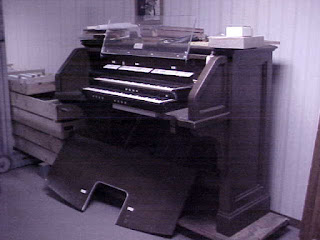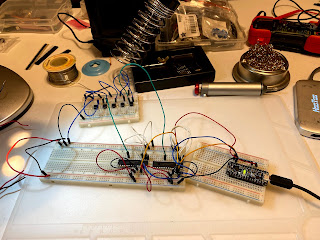Back in the Saddle ... er, Bench
My new itsybitsy controllers arrived last week, and I naturally raced ahead to try to get as much done with as least effort as possible right away right now can't wait. Right, you know how that goes. So it wasn't quite working, and then we had to leave for Arisia, with my organ all taken apart and filling the living room with random parts again.
We came home. Cons being what they are, Brian caught the flu, or near enough, then naturally I got it too and there things sat, taking up my living room, being unplayable. So, I sez, I'm achy and feverish and likely to screw everything up, let's go step by step, very slowly, and test everything. Like I should have done in the first place.
I built the electronics for the pedalboard in two pieces - a 1/4 proto board containing the metro mini only, and a 1/2 proto board containing the two port expanders needed to read 32 keys. This wasn't brilliant forethought on my part, it was just what I happened to have on hand. Nonetheless, it made life much simpler.
I removed the 1/4 board with the perfectly working but incorrect controller and brought it back to my bench.
Build a 1/2 proto board with 2 port expanders wired to be addresses 0 and 1 - just like the pedalboard and also just like the left half of the manuals. Repetition and swap-ability is awesome.
Test that the new port expander board works by hooking it up to the old mini controller. It didn't, I'd made a wiring mistake. Good to be testing with a known-good controller, right? My solder sucker is one of my favorite toys. All better now.
Solder pins to a shiny new itsybitsy board and wire it to a 1/4 protoboard with ground, power, clock and data sent out to the rails, just like with the metro.
Test the built-in program (it pulses note 64 and the led) with the Audio MIDI Setup utility. This caused some grief until I realized the usbc hub widget I'm using is the problem and I swap it for a straight Apple adapter. I'm going to have to find something that will act as a hub for all the itsys, but that is a problem for another day.
Upload the latest organ midi scanner sketch to the itsy. There are bugs, I fixed them.
Plug in an 8 Hall sensor array, built for the manuals and tested on my little test widget as good.
End to end test Magnet -> Hall sensor -> port expander -> itsybitsy -> Mac -> Organteq
Success - waving a magnet in front of the sensors fires the keys in Organteq. Here is a preview of my sensor array - if it actually fits on the organ and works well you'll get more details.
Back to the physical pedalboard where I have swapped in a new itsybitsy. Upload my sketch to it and try pressing pedals. Success!
I hooked up the pedalboard to the organ and put the bench in place, so I have a living room again and when I'm rested up I can practice pedal exercises once more.
Final test - connect both the pedal and great itsybitsy controllers to my laptop and check the results. - Organteq (which is good for testing since it loads so much faster than Hauptwerk or GrandOrgue) registers both and they work together!
Next step - back to working on installing sensors into the manuals, where I was before I discovered the controller issue.
Next...
We came home. Cons being what they are, Brian caught the flu, or near enough, then naturally I got it too and there things sat, taking up my living room, being unplayable. So, I sez, I'm achy and feverish and likely to screw everything up, let's go step by step, very slowly, and test everything. Like I should have done in the first place.
I built the electronics for the pedalboard in two pieces - a 1/4 proto board containing the metro mini only, and a 1/2 proto board containing the two port expanders needed to read 32 keys. This wasn't brilliant forethought on my part, it was just what I happened to have on hand. Nonetheless, it made life much simpler.
I removed the 1/4 board with the perfectly working but incorrect controller and brought it back to my bench.
Build a 1/2 proto board with 2 port expanders wired to be addresses 0 and 1 - just like the pedalboard and also just like the left half of the manuals. Repetition and swap-ability is awesome.
Test that the new port expander board works by hooking it up to the old mini controller. It didn't, I'd made a wiring mistake. Good to be testing with a known-good controller, right? My solder sucker is one of my favorite toys. All better now.
Solder pins to a shiny new itsybitsy board and wire it to a 1/4 protoboard with ground, power, clock and data sent out to the rails, just like with the metro.
Test the built-in program (it pulses note 64 and the led) with the Audio MIDI Setup utility. This caused some grief until I realized the usbc hub widget I'm using is the problem and I swap it for a straight Apple adapter. I'm going to have to find something that will act as a hub for all the itsys, but that is a problem for another day.
Upload the latest organ midi scanner sketch to the itsy. There are bugs, I fixed them.
Plug in an 8 Hall sensor array, built for the manuals and tested on my little test widget as good.
End to end test Magnet -> Hall sensor -> port expander -> itsybitsy -> Mac -> Organteq
Success - waving a magnet in front of the sensors fires the keys in Organteq. Here is a preview of my sensor array - if it actually fits on the organ and works well you'll get more details.
Back to the physical pedalboard where I have swapped in a new itsybitsy. Upload my sketch to it and try pressing pedals. Success!
I hooked up the pedalboard to the organ and put the bench in place, so I have a living room again and when I'm rested up I can practice pedal exercises once more.
Final test - connect both the pedal and great itsybitsy controllers to my laptop and check the results. - Organteq (which is good for testing since it loads so much faster than Hauptwerk or GrandOrgue) registers both and they work together!
Next step - back to working on installing sensors into the manuals, where I was before I discovered the controller issue.
Next...





Comments
Post a Comment